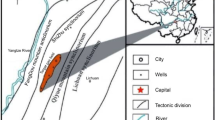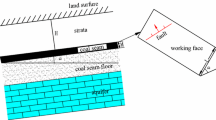Abstract
It is a great challenge to match and predict the production performance of coalbed methane (CBM) wells in the initial production stage due to heterogeneity of coalbed, uniqueness of CBM production process, complexity of porosity-permeability variation and difficulty in obtaining some key parameters which are critical for the conventional prediction methods (type curve, material balance and numerical simulation). BP neural network, a new intelligent technique, is an effective method to deal with nonlinear, instable and complex system problems and predict the short-term change quantitatively. In this paper a BP neural model for the CBM productivity of high-rank CBM wells in Qinshui Basin was established and used to match the past gas production and predict the futural production performance. The results from two case studies showed that this model has high accuracy and good reliability in matching and predicting gas production with different types and different temporal resolutions, and the accuracy increases as the number of outliers in gas production data decreases. Therefore, the BP network can provide a reliable tool to predict the production performance of CBM wells without clear knowledge of coalbed reservoir and sufficient production data in the early development stage.
Similar content being viewed by others
References
Zhang P H. Study on CBM well capacity grading scheme. China Coalbed Methane, 2007, 4: 28–30
Yang Y G, Qin Y. Study and application on random dynamic model of the coalbed methane output forecasting. J China Coal Soc, 2001, 26: 122–125
Aminian K, Ameri S, Bhavsar A, et al. Type curves for coalbed methane production prediction. SPE 91482, SPE E Reg Conf, 2004
Aminian K, Ameri S, Bhavsar A, et al. Type curves for production prediction and evaluation of coalbed methane reservoirs. SPE 97957, SPE E Reg Conf, 2005
King G R. Material-balance techniques for coal-seam and Devonian shale gas reservoirs with limited water Influx. SPE Reservoir Eng, 1993, 67–72
Ahmed T, Centilmen A, Roux B. A generalized material balance equation for coalbed methane reservoirs. SPE 102638, SPE Tech Conf, 2006
Zhang J, Wang Z M. Application of material balance method to productivity forecast in coalbed methane reservoir. Coal Geol Explor, 2009, 37: 23–26
Seidle J P, Arri L E. Use of conventional reservoir models for coalbed methane simulation. SPE 21599, CIM/SPE Int Tech, 1990
Pekot L J, Reeves S R. Modeling the effects of matrix shrinkage and differential swelling on coalbed methane recovery and carbon sequestration. Int Coalbed Methane Symp, 2003. 0328
Manik J, Ertekin T, Kohler T E. Development and validation of a compositional coalbed simulator. J Can Petro Tech, 2002, 41: 39–45
Enoh M E. A Tool to Predict the Production Performance of Vertical Wells in a Coalbed Methane Reservoir. Dissertation of Masteral Degree. Morgantown: West Virginia University, 2007
Wang X M, Zhang Q, Zhang P H, et al. Discussion on the method of history matching of coalbed methane well. Coal Geol Explor, 2003, 31: 20–22
Su F Y, Cai Y F. Application of numeral simulation in Liulin test zone of coalbed gas. Nat Gas Ind, 2004, 24: 95–96
Zhang X M, Tong D K, Sun B Q. Numerical simulation of tight coalbed methane reservoir with the matrix shrinkage effect. J Basic Sci Eng, 2009, 17: 690–696
Zhu W P, Guo D L, Zeng X H, et al. Impact of coalbed stress sensibility on CBM output prediction. Coal Geol China, 2010, 22: 28–31
Luo S Q, Lang Z X. Primary study of factors influencing coalbed gas productivity. Fault-Block Oil Gas Field, 1997, 4: 42–47
Mohaghegh S, Arefi R, Bilgesu H I, et al. Design and development of an artificial neural network for estimation of formation permeability. SPE 28237, P SPE Petr Comp Conf, Dallas, TX, 1994
Mohaghegh S. Neural network: what it can do for petroleum engineers. J Petr Tech, 1995, 47: 42
Mohaghegh S, Arefi R, Ameri S. A methodological approach for reservoir heterogeneity characterization using artificial neural networks. SPE 28394, P SPE Ann Conf, New Orleans, LA, 1994
Kumoluyi A, Daltaban T. Higher-order neural networks in petroleum engineering. SPE 27905, P SPE W Reg, Long Beach, CA, 1994
White A, Molnar D, Aminian K, et al. The application of ANN for zone identification in a complex reservoir. SPE 30977, P SPE E Reg, Morgantown, WV, 1995
Riera A J. Predicting Permeability and Flow Capacity Distribution with Back-Propagation Artificial Neural Networks. Dissertation of Masteral Degree. Morgantown: West Virginia University, 2000
Li Y, Yu B M. Study of the starting pressure gradient in branching network. Sci China Tech Sci, 2010, 53: 2397–2403
Ding Y L, Deng Y, Li A Q. Study on correlations of modal frequencies and environmental factors for a suspension bridge based on improved neural networks. Sci China Tech Sci, 2010, 53: 2501–2509
Zhong D H, Ren B Y, Li M C, et al. Theory on real-time control of construction quality and progress and its application to high arc dam. Sci China Tech Sci, 2010, 53: 2611–2618
Cai L, Ma S Y, Cai H T, et al. Prediction of SYM-H index by NARX neural network from IMF and solar wind data. Sci China Ser E-Tech Sci, 2009, 52: 2877–2885
Runelbart D, Meclelland J. Parallel Distributed Processing: Explorations in the Microstructure of Cognition. Cambridge: Bradford Books, MIT Press, 1986
Zhu K, Wang Z L. Mastering Matlab Neural Networks. Beijing: Elect Ind Press, 2010
Lian C B, Zhao Y J, Li H L, et al. The main controlling factors of coal-bed gas content and it’s quantitative prediction. J China Coal Soc, 2005, 30: 726–729
Meng Z P, Tian Y D, Lei Y. Prediction models of coalbed gas content based on BP neural networks and its applications. J China U Min Tech, 2008, 37: 456–461
Author information
Authors and Affiliations
Corresponding author
Rights and permissions
About this article
Cite this article
Lü, Y., Tang, D., Xu, H. et al. Productivity matching and quantitative prediction of coalbed methane wells based on BP neural network. Sci. China Technol. Sci. 54, 1281–1286 (2011). https://doi.org/10.1007/s11431-011-4348-6
Received:
Accepted:
Published:
Issue Date:
DOI: https://doi.org/10.1007/s11431-011-4348-6




